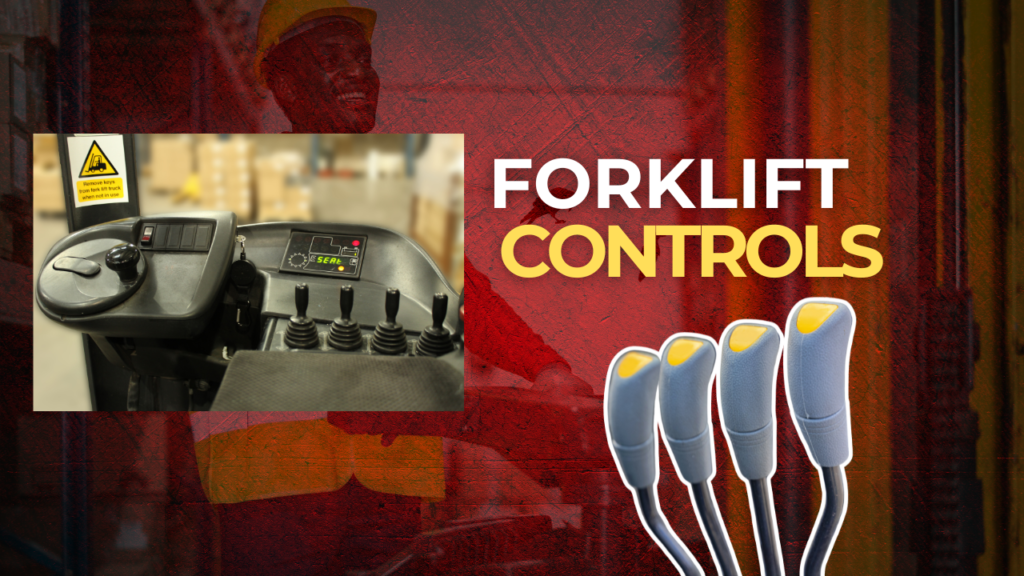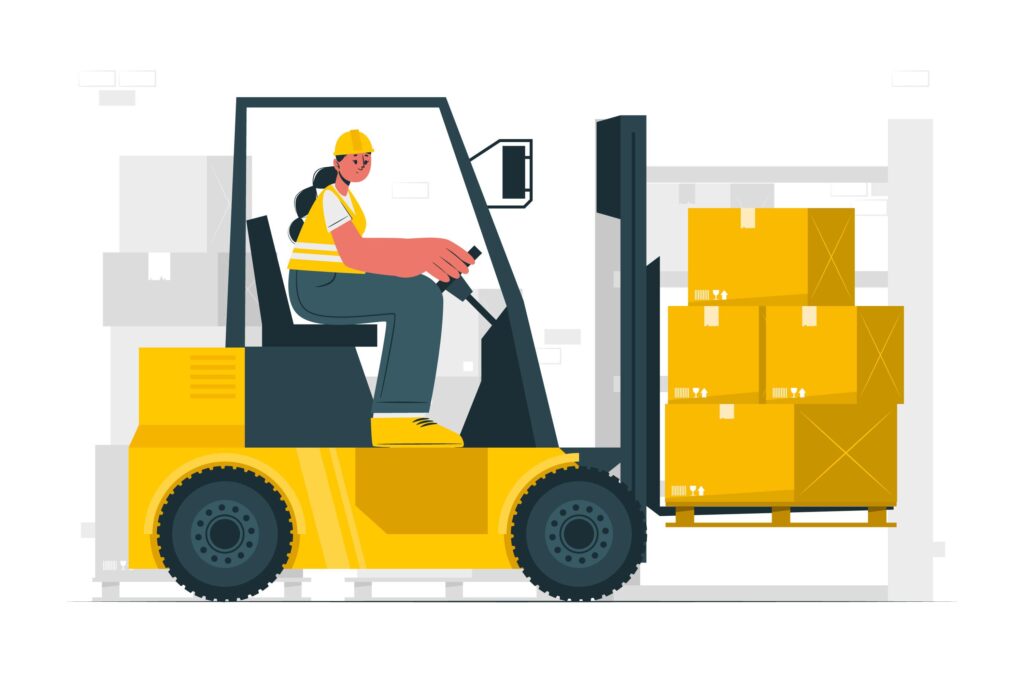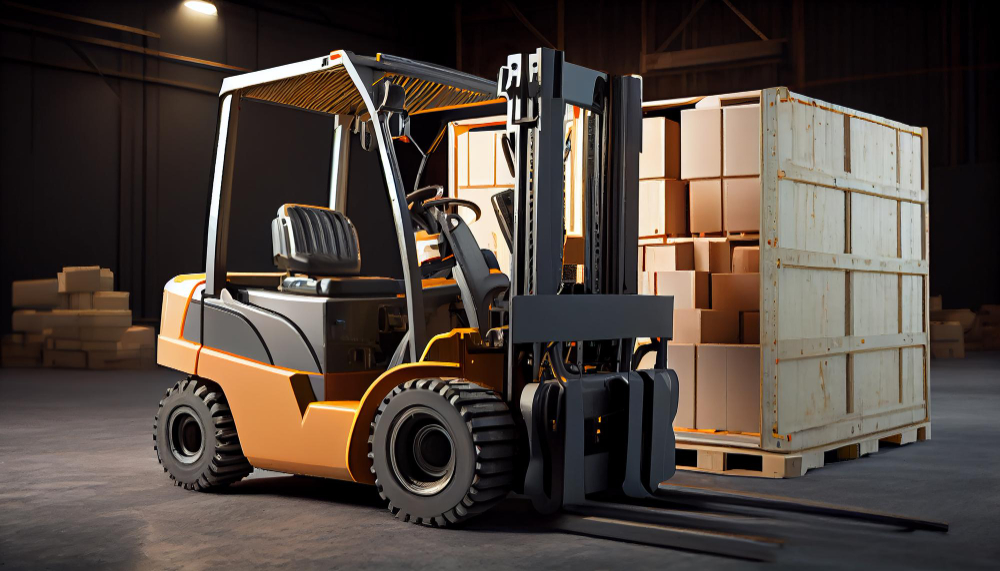How to Use Forklift Controls: Fundamentally, forklift safety is mostly dependent on one key factor: control of the controls. Apart from the forklift training and practice needed of any operator, you also need to know your way around the particular type you’re running.
Different kinds of forklifts, manufacturers, and powertrains affect controls among other factors. Before you use your particular equipment, always acquaint yourself with the controls by consulting the operator’s handbook.
This page provides a broad summary of fundamental forklift controls—which you will find on many machines and how to operate them. We also walk over some pointers for using a forklift safely.
Sit-Down Forklift Controls
Commonly utilized forklifts in warehouses are sit-down models. Since the operator may sit down operating the equipment, they fit for longer shifts.
Usually both steer from the back, however sit-down forklifts might have four or three wheels. Because three-wheel vehicles have a reduced turning radius, they can negotiate smaller aisles and confined areas.
There are both electric and internal combustion engines available in this kind of forklift. Each has comparable controls. The fundamental ones you will find on a sit-down forklift are broken out here.
Steering Wheel
Like one you may find in a vehicle or truck, a forklift steering wheel links to the steering column to enable turn navigation. On a forklift, though, the steering wheel is designed specifically. It features a knob allowing one hand to turn the machine.
Forklift trucks move from behind. The front serves as the pivot point, hence the front wheels remain motionless. Using a three-wheeled forklift, if you turn all the way to one side, the back end swings to provide 360 degrees of turn. The control panel will indicate the direction of the wheel pointing, therefore guiding your machine’s location.
Directional Control Lever
The directional control lever lets you decide whether the forklift stays in neutral or goes forward or backwards. Pull the lever in the direction you wish to travel, then move the machine using the accelerator pedal. Reversing allows you to use your mirrors for sight.
Hydraulic Lift Controls
Usually, three levers regulate the hydraulics’ lifting mechanisms as well as the fork’s movement.
- Left lever: Pulling this back elevates the forks; pressing it forward drives them down.
- Center lever: Pulling this back causes the mast to slink backwards; pushing it forward causes it to slink forward.
- Right lever: Usually running from side to side, this is an auxiliary lever moving the weight.
Apart from these levers, reach trucks might feature a fourth lever regulating the reach capacity, hence extending the forks. This fourth level might also regulate accessories like clamps.
Pedals
On electric forklifts, there typically are two pedals and three pedals on gas-powered vehicles.
- Right: The accelerator or gasoline pedal is this one.
- Center: The braking pedal is this one.
- Left: Only on gas-powered machinery is this third pedal—the inching pedal. It puts the forklift in neutral, like a clutch pedal, allowing you to utilize the throttle to provide additional gas to the hydraulics.
Other Controls
The following are other controls found in a sit-down forklift’s cab:
- Parking brake maintains machine stability and stop when you park it. On either the left or the right side, it may be a lever or a button.
- You insert the key here to turn on the machine.
- Showing you vital information including charge level and any warning lights, this panel
- Pressing this red button instantly stops the machine in an emergency.
- Lights: These brighten your surrounds. Usually, the controls run straight alongside the steering wheel.
- Horn: You can use this to indicate your presence on the project or otherwise warn your staff, just like in a car. Usually it is situated on the side of the directional control lever.
Stand-Up Forklift Controls
When operators must regularly climb on and off the machine or when more vision is required, stand-up forklifts are sometimes employed. Since the cab is open, the forklift operator has simple access to view of surroundings. To transfer goods as required, they may also readily go on and off the machine.
Mainly because both forward and reverse, as well as hydraulics, are handled by hand using one lever, the controls differ from those of a sit-down forklift.
Steering Tiller
The multifunction lever handles most of your forklift directional controls, while the steering tiller lets you maneuver. Rather than a full steering wheel, stand-up forklifts usually include a tiller—a lever with a knob on the end. Like on a complete wheel, you spin the knob to steer. Your right handles the hydraulic controls; your left hand will help you to steer.
Multitask Lever
Most of the forklift’s operations are under the multifunctional lever control. Turning the whole lever left and right drives the machine both forward and backwards. Though the machine will continue roll, letting the lever go returns it to neutral.
It governs the forks as well. To raise and lower the forks, turn the knob on the lever’s end left and right. Press forward to tilt the forks down; press the directional key back to tilt the forks up. Press left to push the forks to the left; press right to slide them to the right. Underneath may be buttons extending the forks out and back.
Order Picker Forklift Controls
Instead of picking complete pallets, order pickers—a kind of forklift—lift operators up to warehouse shelves to choose individual goods. Usually operating at considerable heights where fall protection is needed, keep in mind to wear and properly fasten the harness when running an order picker.
Steering Wheel
Usually found on the control panel in the cab, the steering wheel of an order picker is flat. It also features a knob for one hand turning action.
Control Lever or Twist Grip
You maneuver the machine using the control lever, just as with a stand-up forklift. To forward and backwards, you move the complete lever to the left and right. The machine will continue roll while the lever is in the neutral center position.
Like a stand-up forklift, the controls to raise and lower the platform could be on a knob on the end of this lever or they might be distinct buttons on the control panel. Also on this lever might be the horn.
Some machines feature a twist grip instead of a lever, which you turn in the direction you wish to travel.
Floor Pedals
Order pickers feature a “dead man pedal” on the platform you need to press for the machine to run, same as a stand-up forklift. Except in an emergency, never use this to stop the machine. It might cause you to lose balance and fall and stops the machine suddenly.
Order pickers additionally have a pallet grab pedal and a brake pedal. The pallet grab pedal locks the pallet grips around their center stinger into place.
Other Controls
Side rails of order pickers must be lowered for operation’s safety. Along with other machine-specific characteristics, they include a display, ignition, and controls for the lights, much as the other kinds of forklifts.
OSHA Requirements for Forklift Operators
Forklifts are complex machinery. Make sure you satisfy the legal criteria to operate one as without the correct training they might be dangerous to drive.
Forklift drivers have to be certified and be more than eighteen years old. Forklifts are classified by the Occupational Safety and Health Administration (OSHA) as motorized industrial vehicles; normal OSHA 29 CFR 1910 provides the guidelines for operating one.
Many companies provide their staff forklift training courses. You might also personally or online enroll in an OSHA-approved training session.



